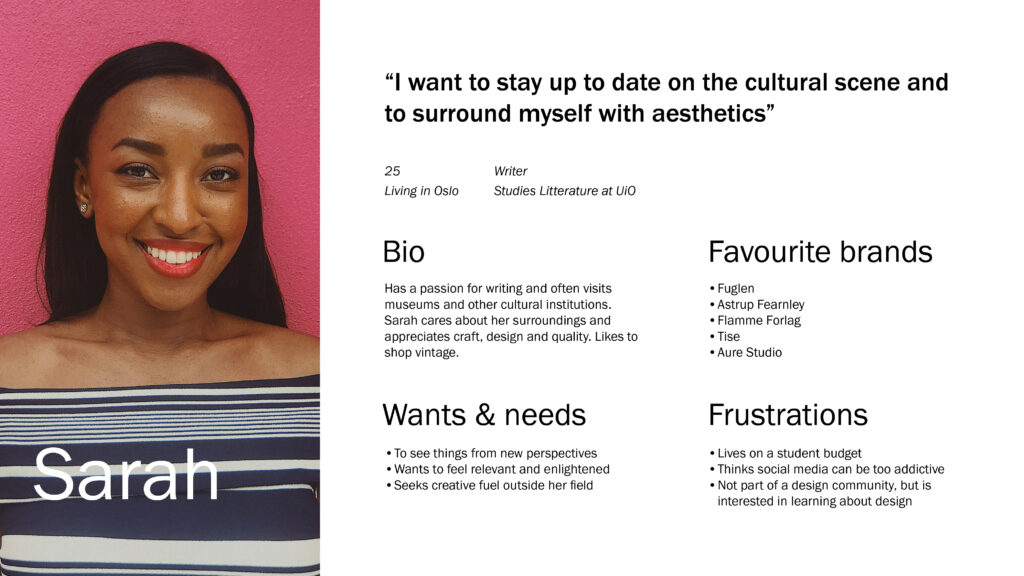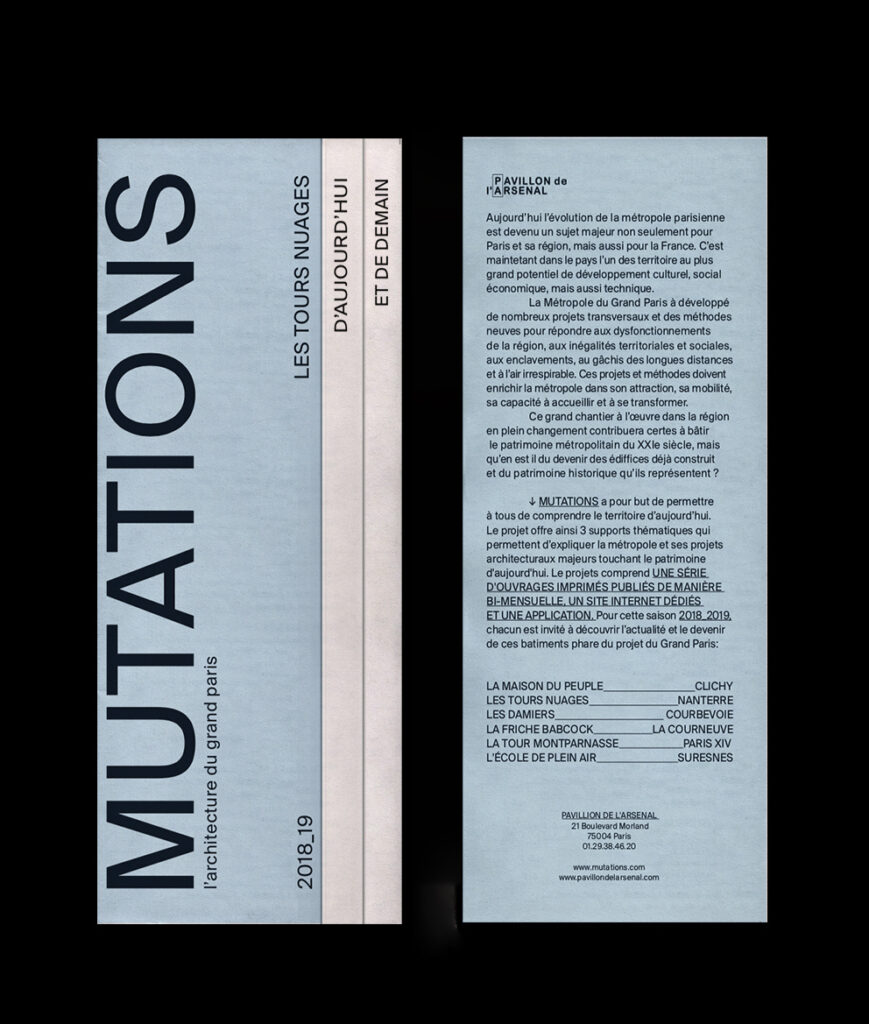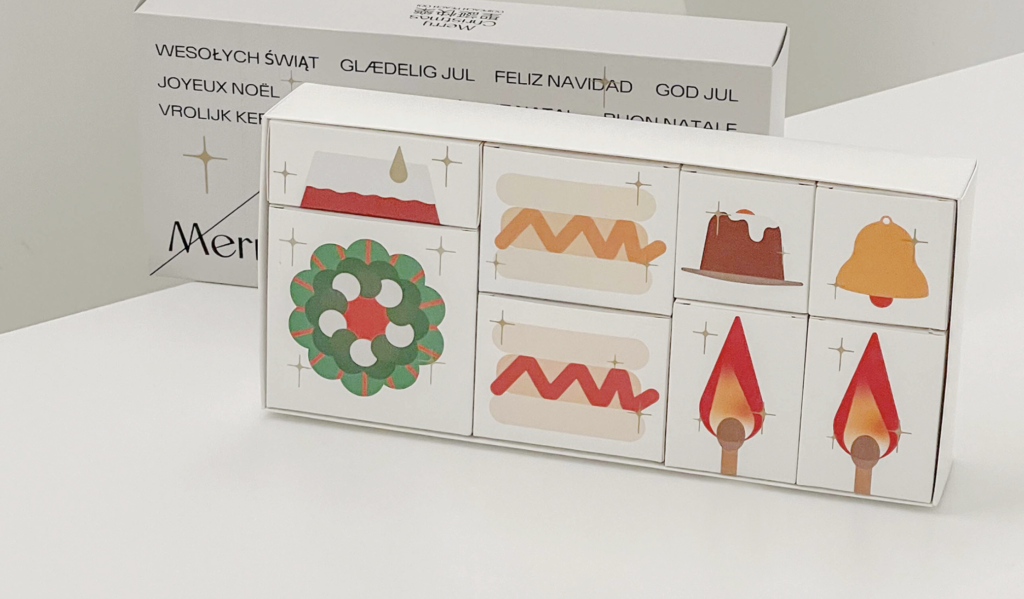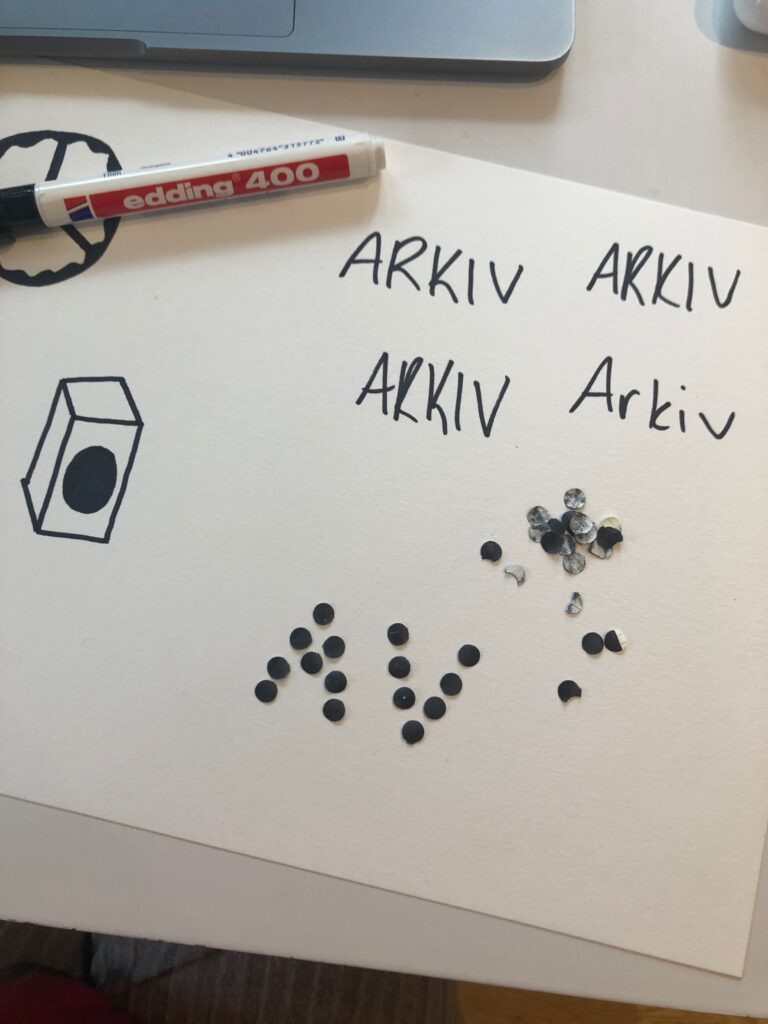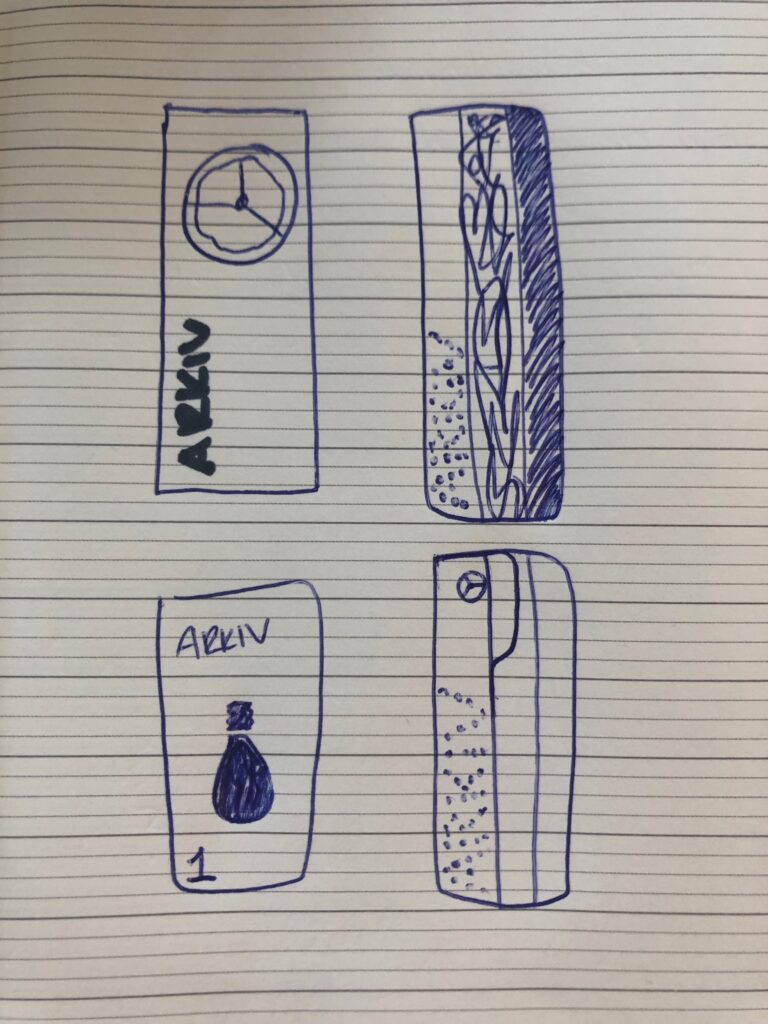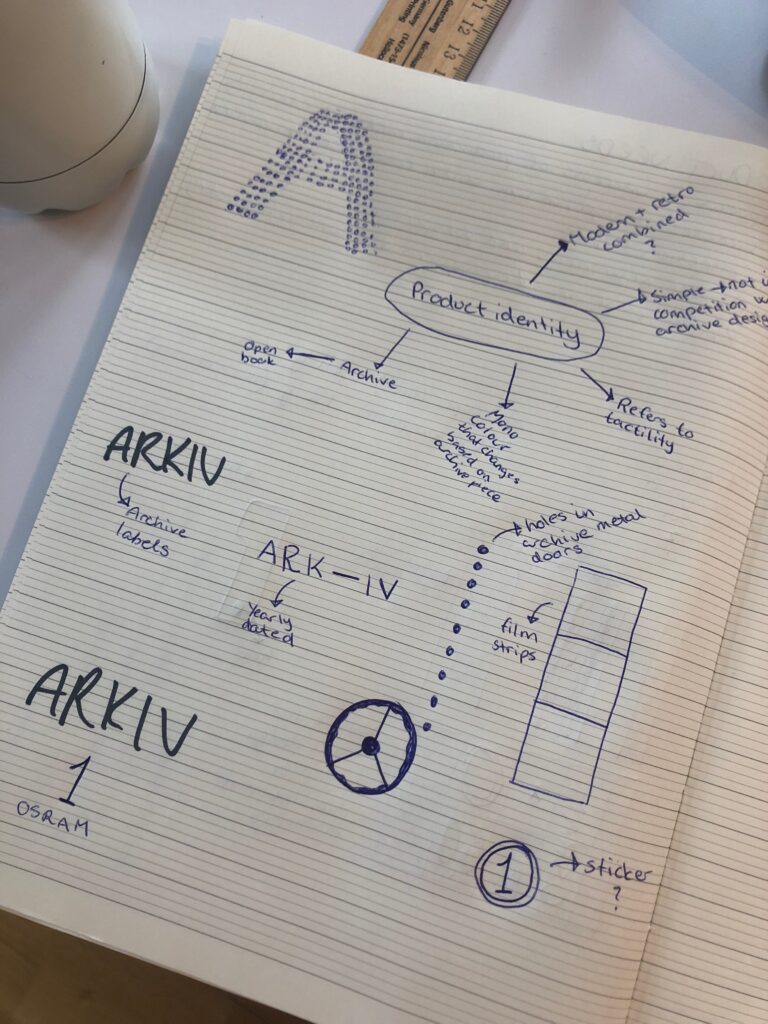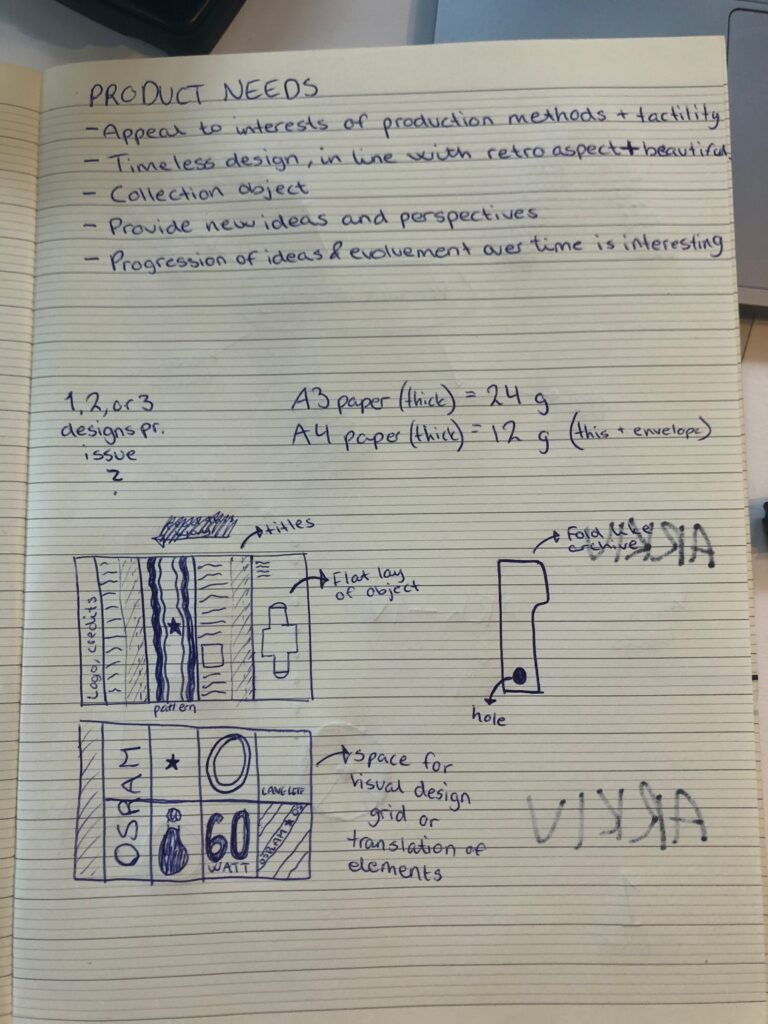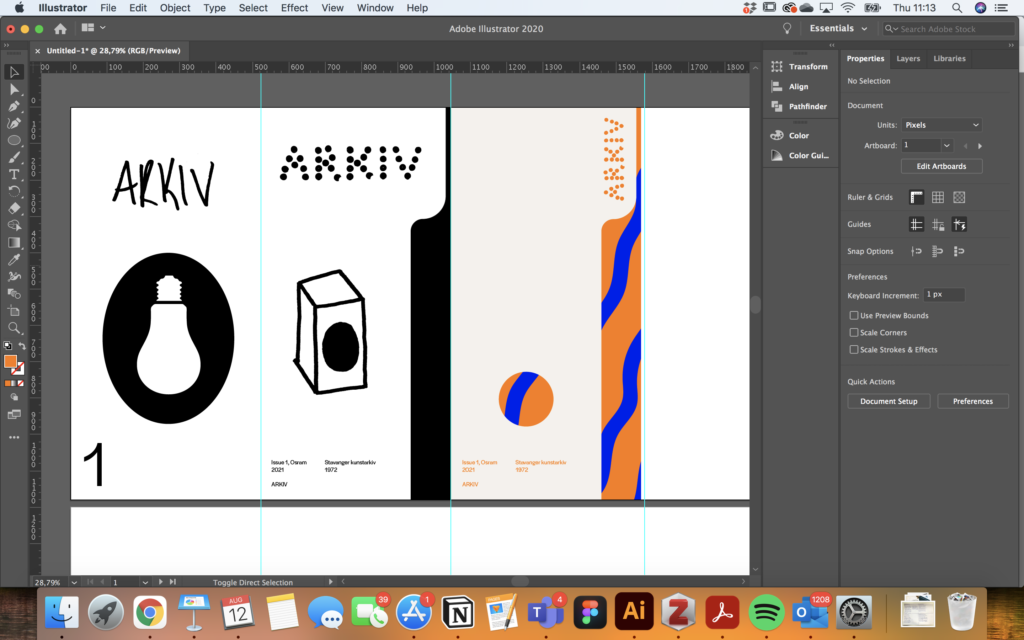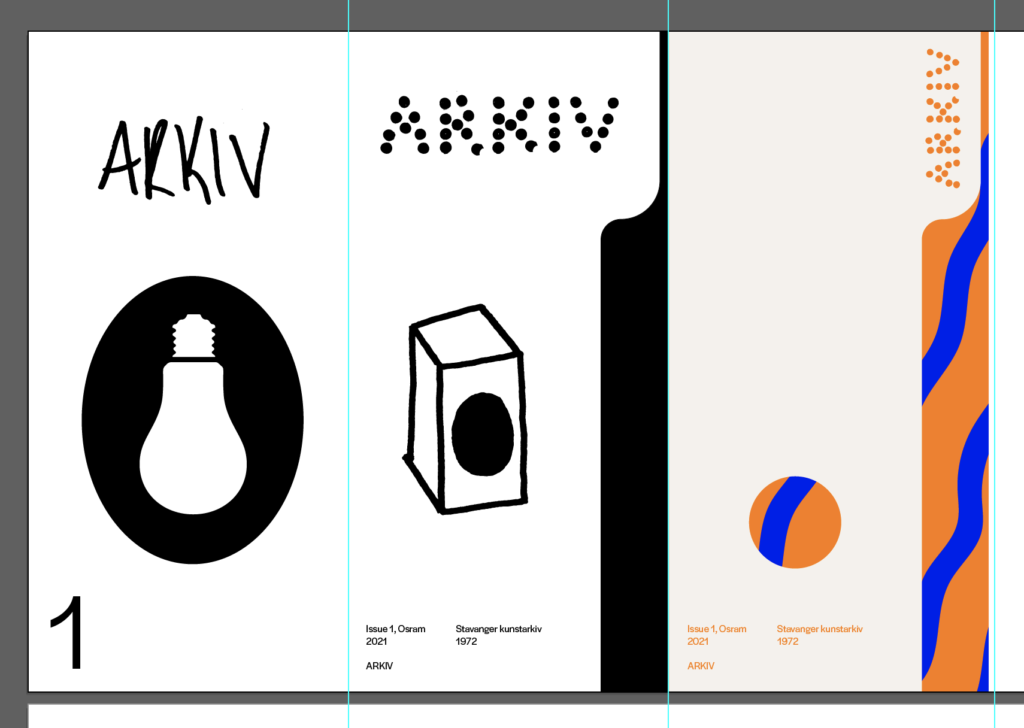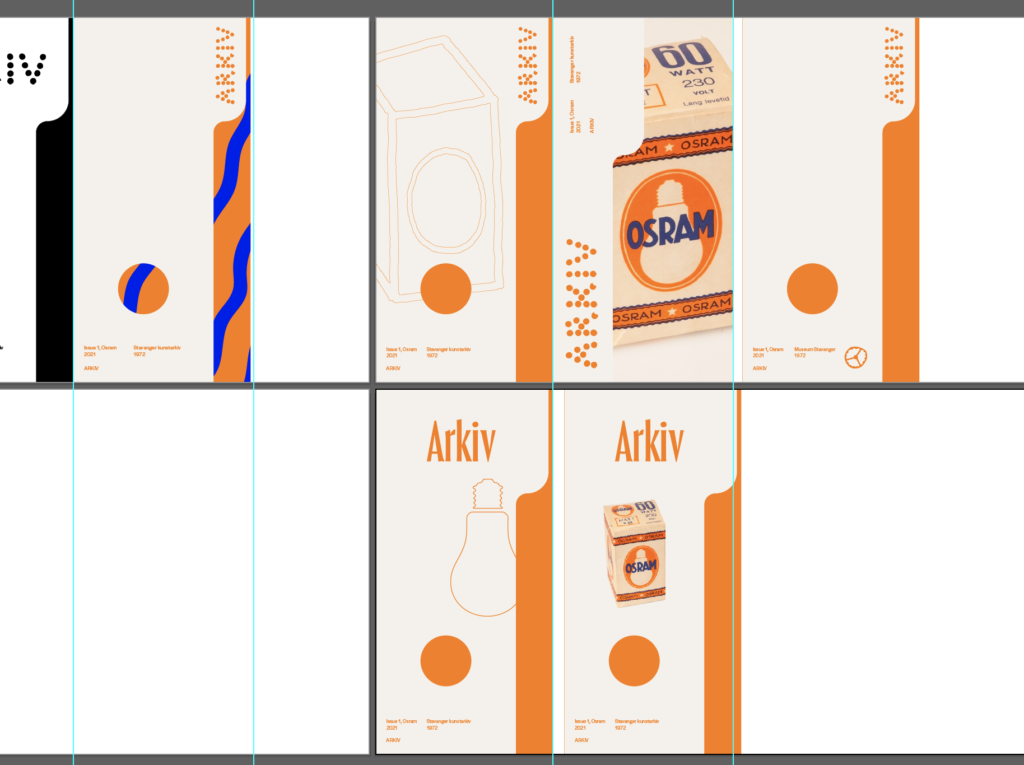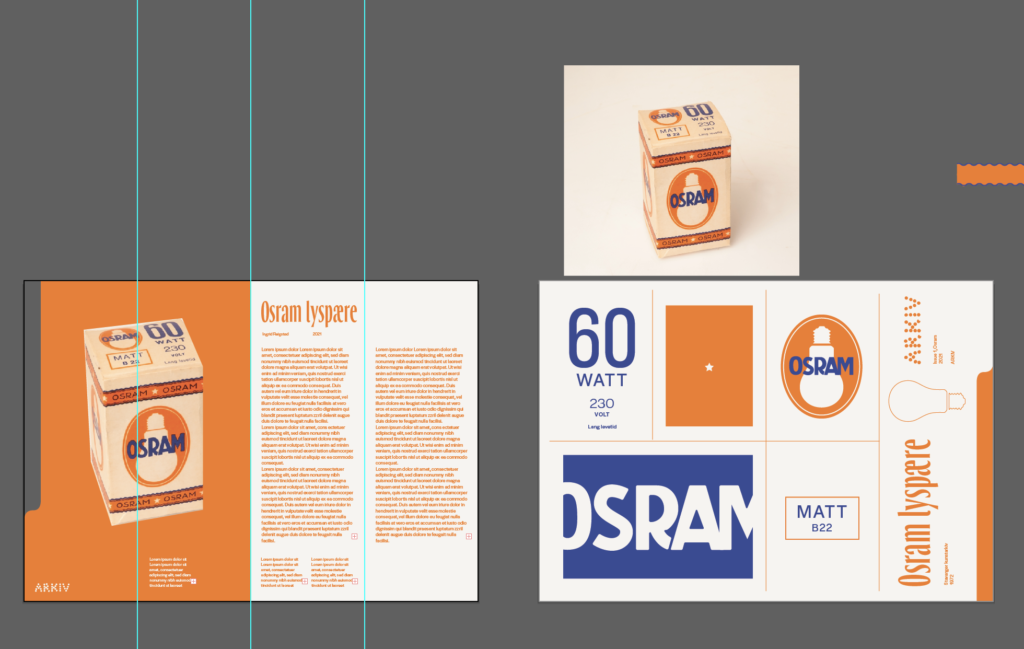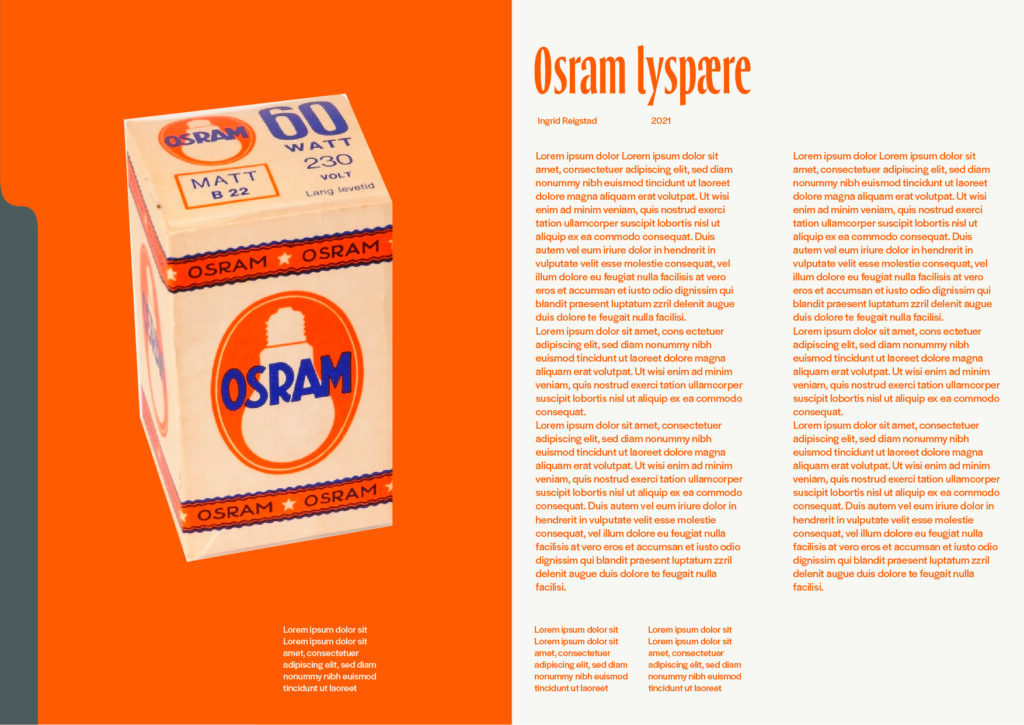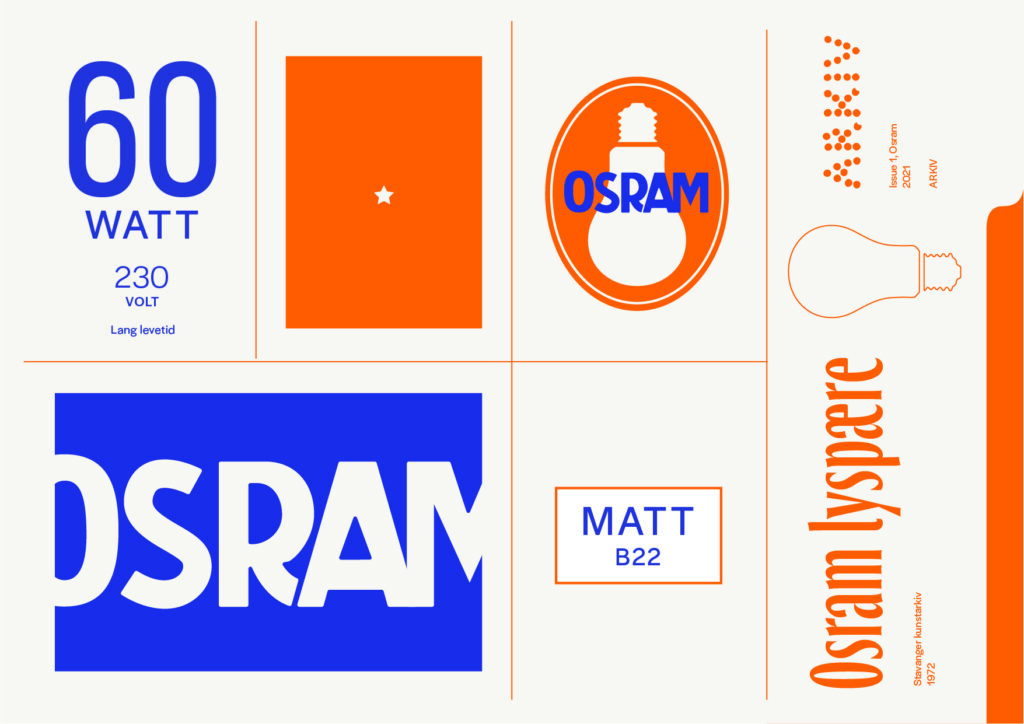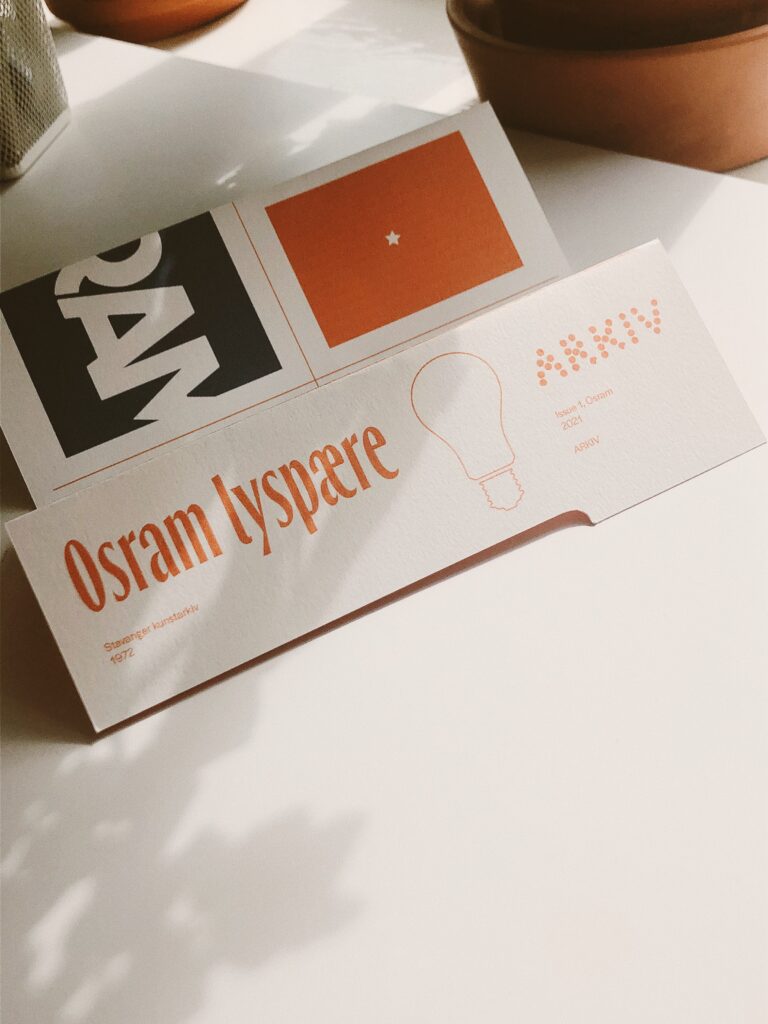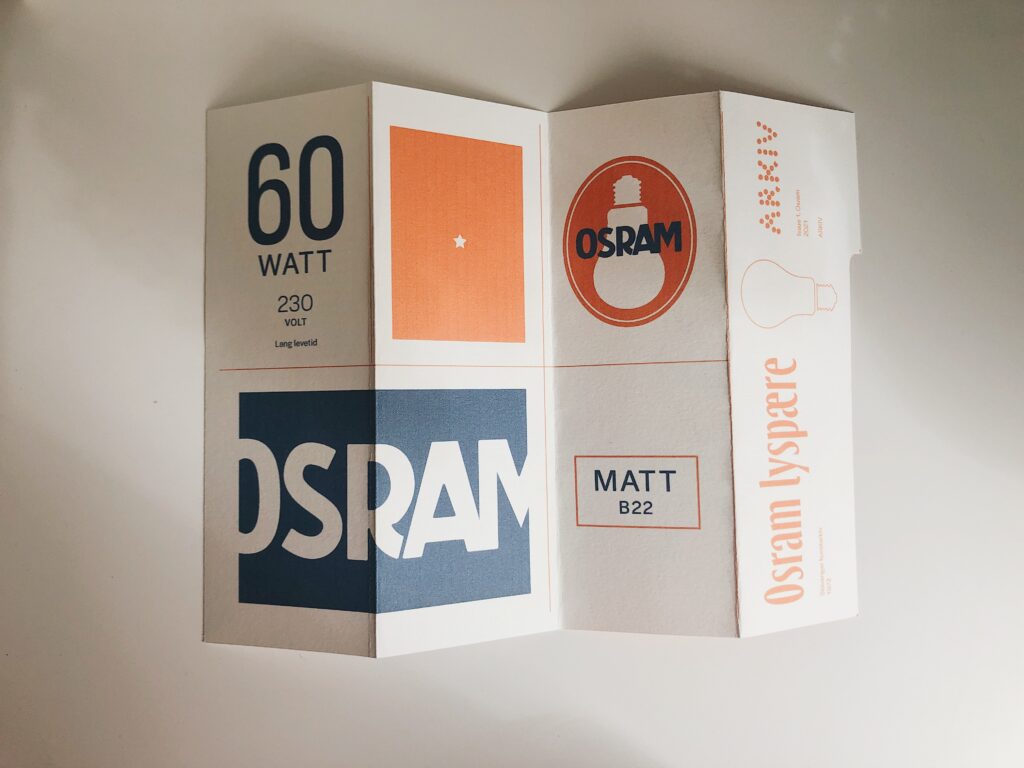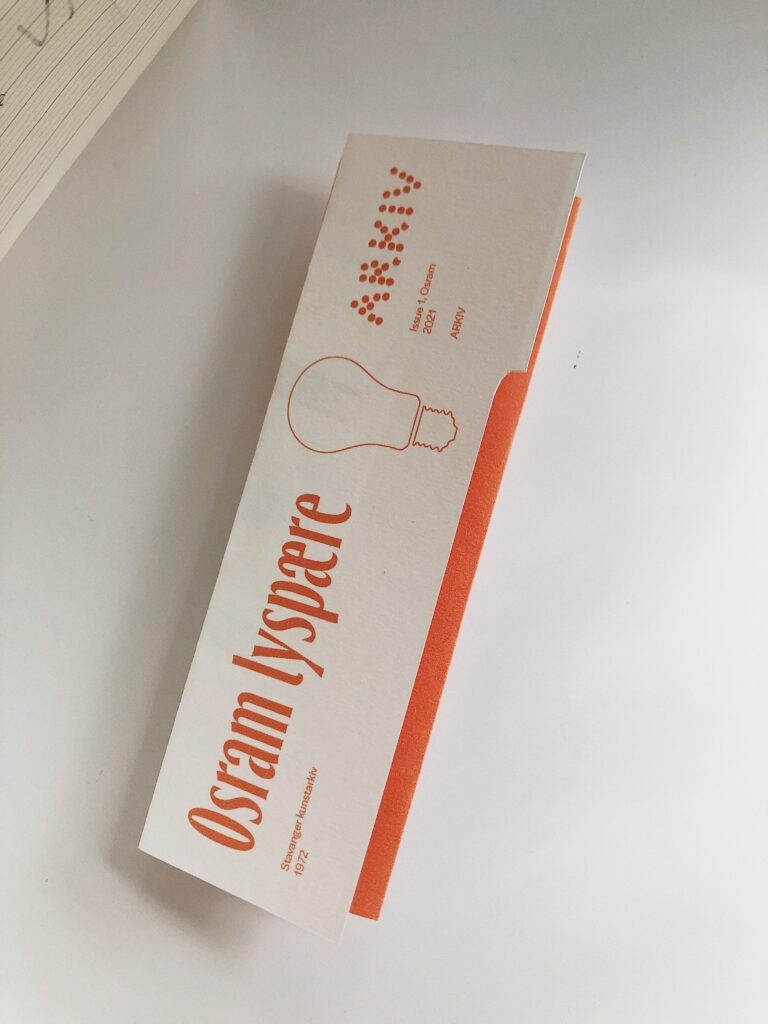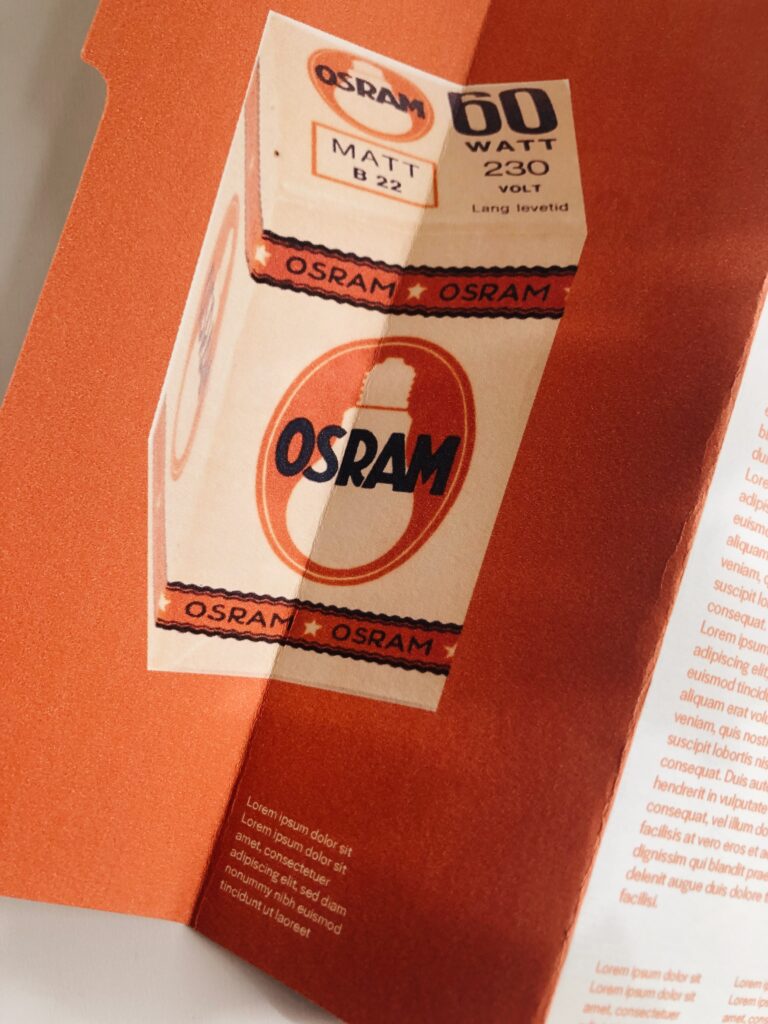Lecture notes
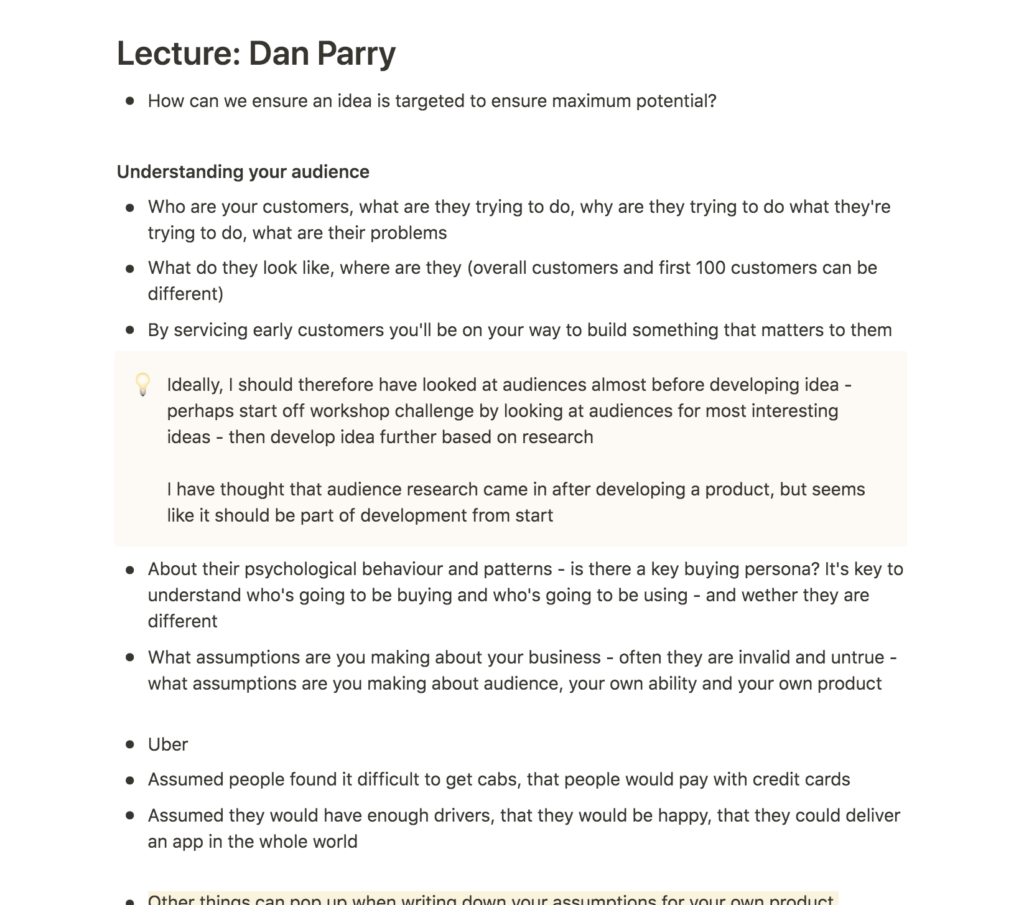
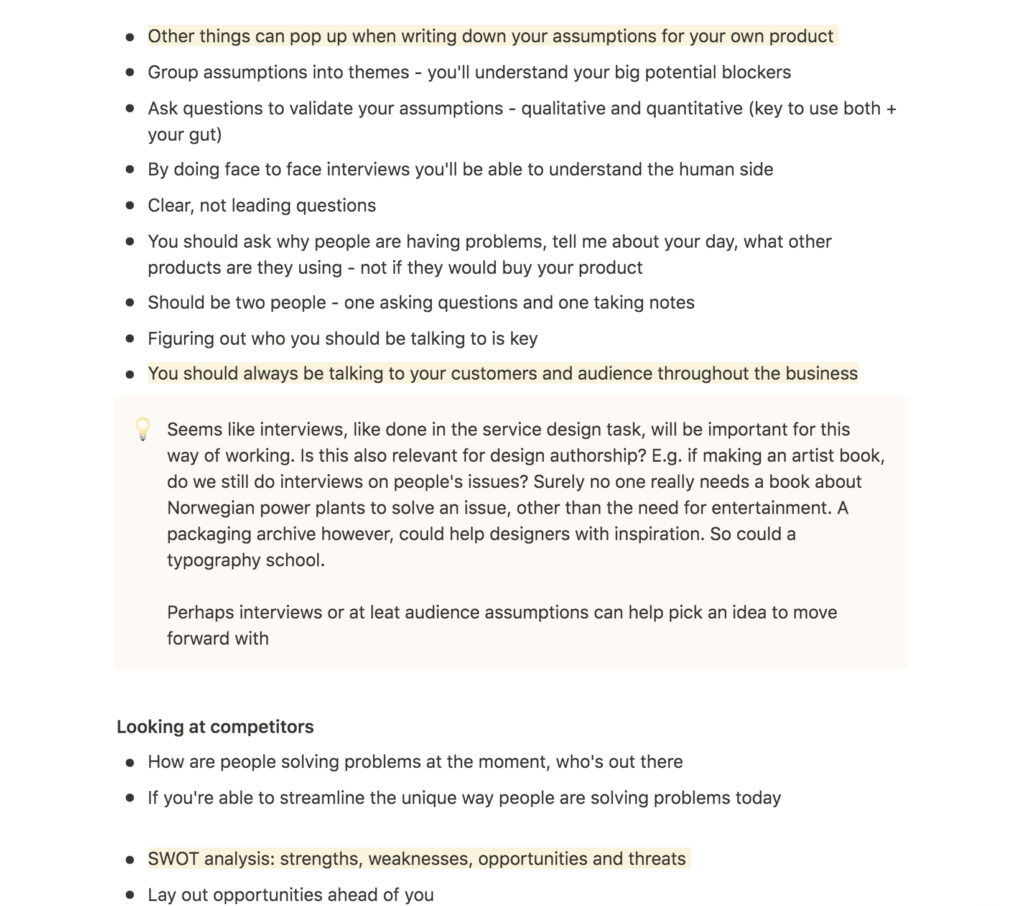
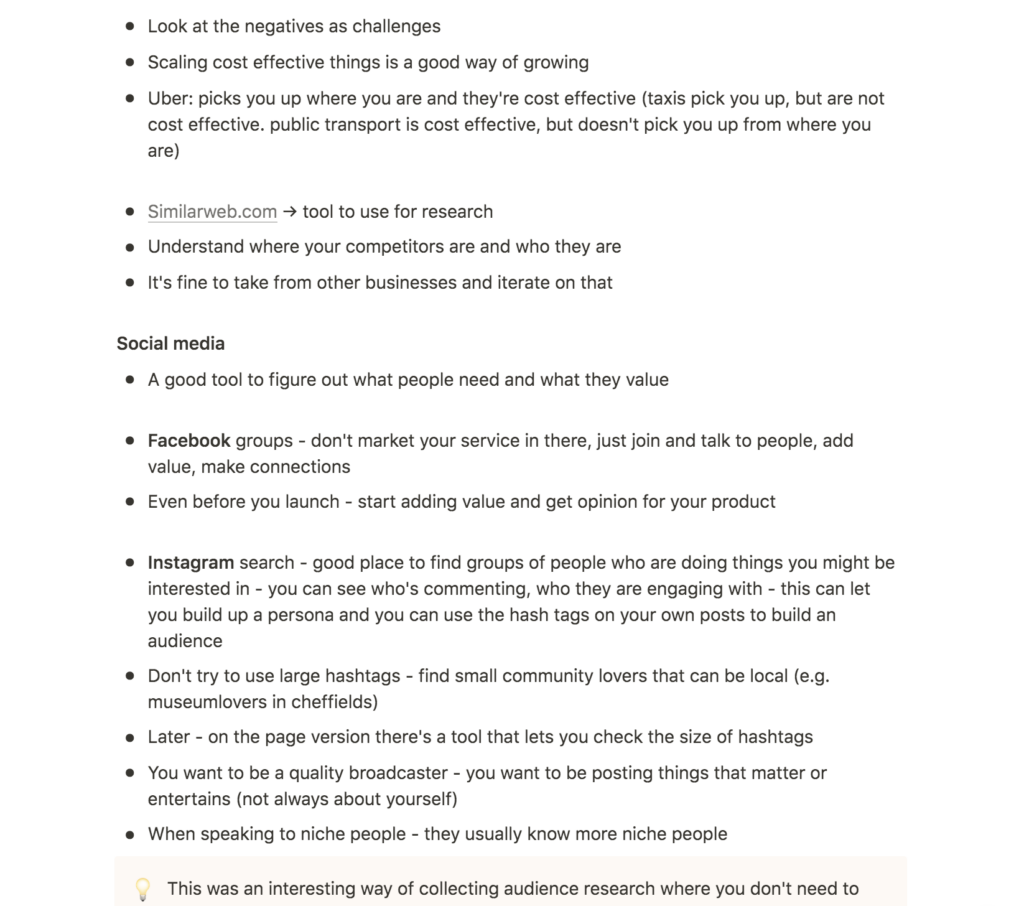

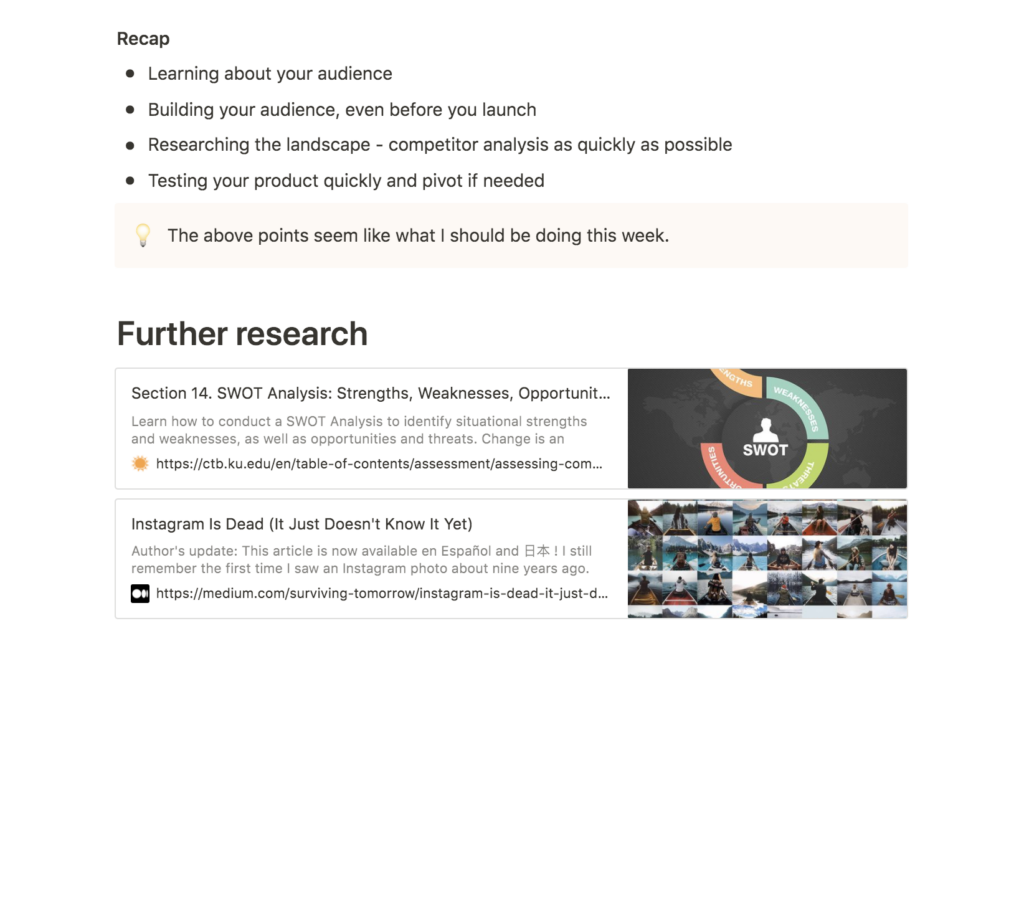
Lecture reflections

Parry’s discussions on audiences were very insightful and made me wonder wether I ideally should have thought about audiences before developing my ideas last week. I have always thought that one would analyse audiences before the development of a project, and it was therefore great to realise that an audience should be part of building something from the beginning (Dan Parry, 2021).
Whilst listening to the lecture I couldn’t help but think that Parry’s talk referred to a more business way of working than I would have thought one ought to use when working on self initiated projects. Take my idea from last week about making a book on Norwegian power plants for example. Surely no audience would be in need of such a book, and I can’t imagine solving an audience’s issues with it.
Yet, on the other hand, I guess an interesting book could provide value in form of entertainment and thus solve the plain issue of boredom. Either way, the audience research method of surveys and interviews seems slightly banal in the context of an “art centred” design project (although I assume interviewing one’s audience will always be beneficial). I guess what I’m trying to ask is wether a self initiated project of this manner should be catered to an audience first, and thus not be solely a product of one’s own interests and ideas as a designer.
Putting these reflections aside, I think Parry’s suggestions on using social media as an audience research method seems clever (Dan Parry, 2021). By analysing the content an audience finds interesting, one might be able to learn more about the best ways of developing an outcome, even if it is something as unusual as an art book on power plants. Surely, one could also benefit from build a community before the launch (as suggested by Parry (Dan Parry, 2021), by sharing content from the project on social media.
I think Parry’s slightly more pragmatic approach to self initiated projects will be interesting to adopt and I look forward to learning how it can contribute to my final outcome.
Resource notes
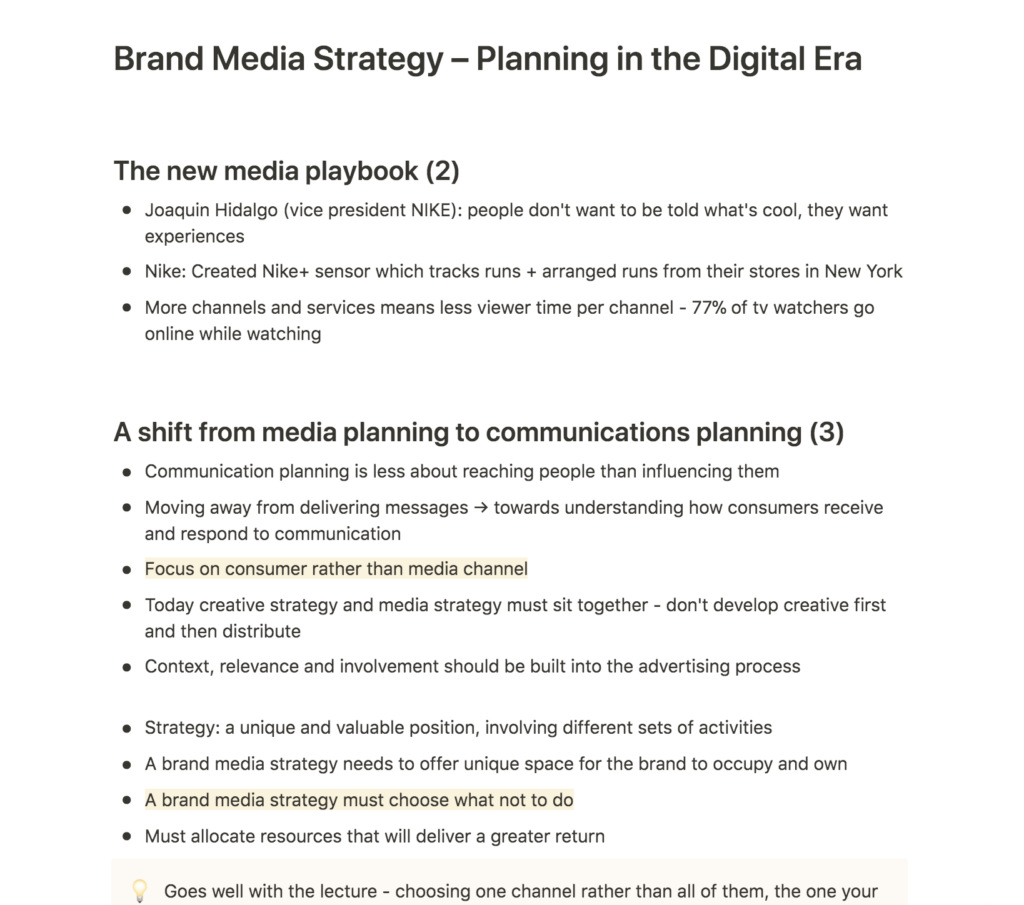
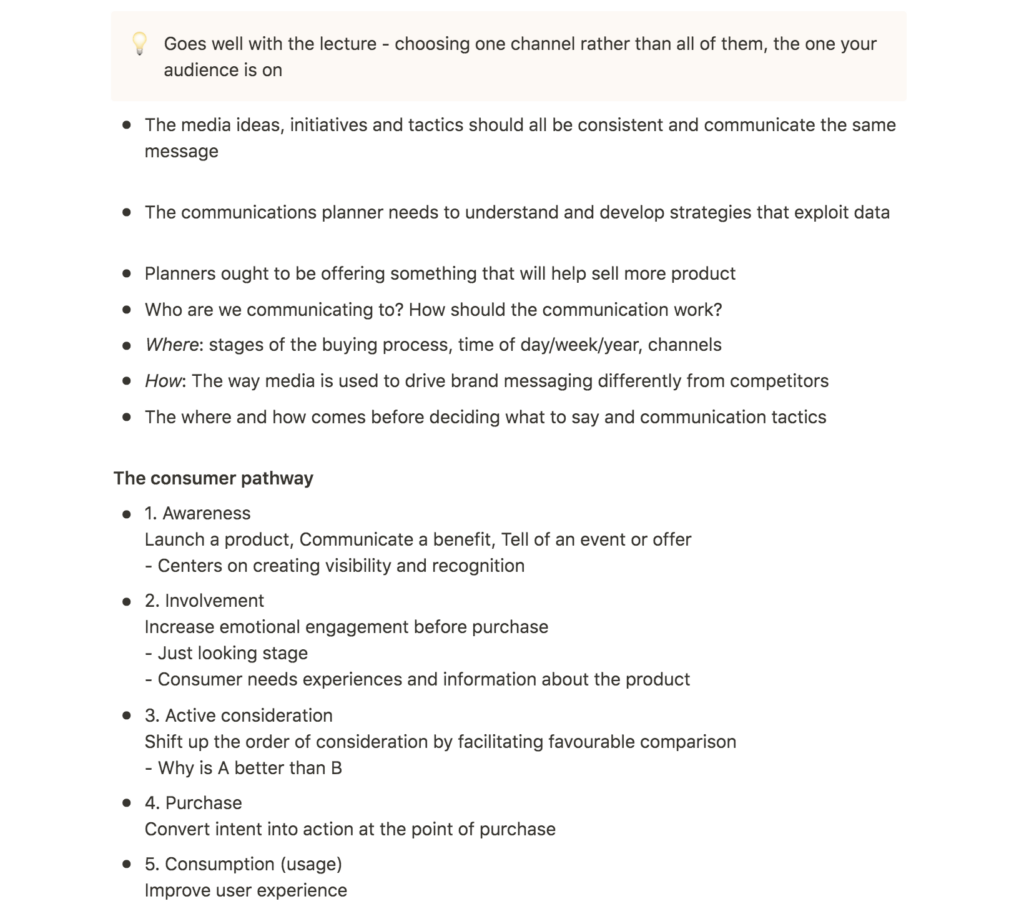
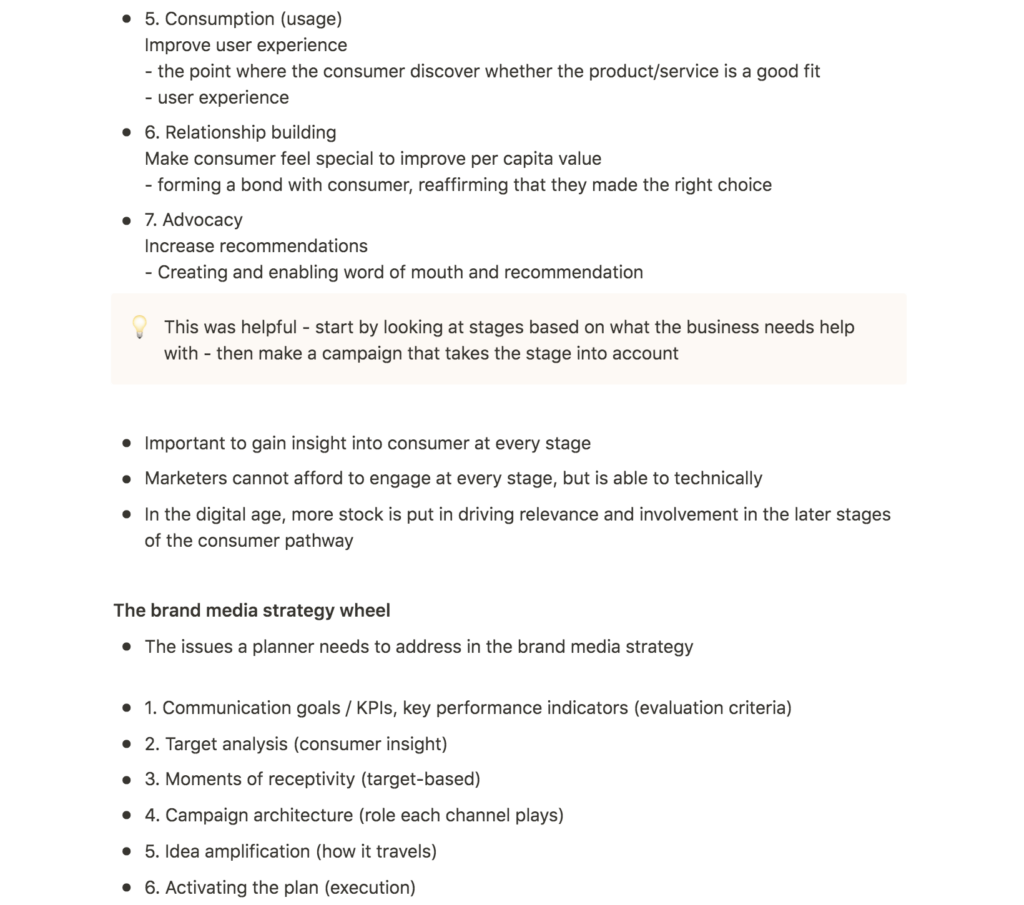
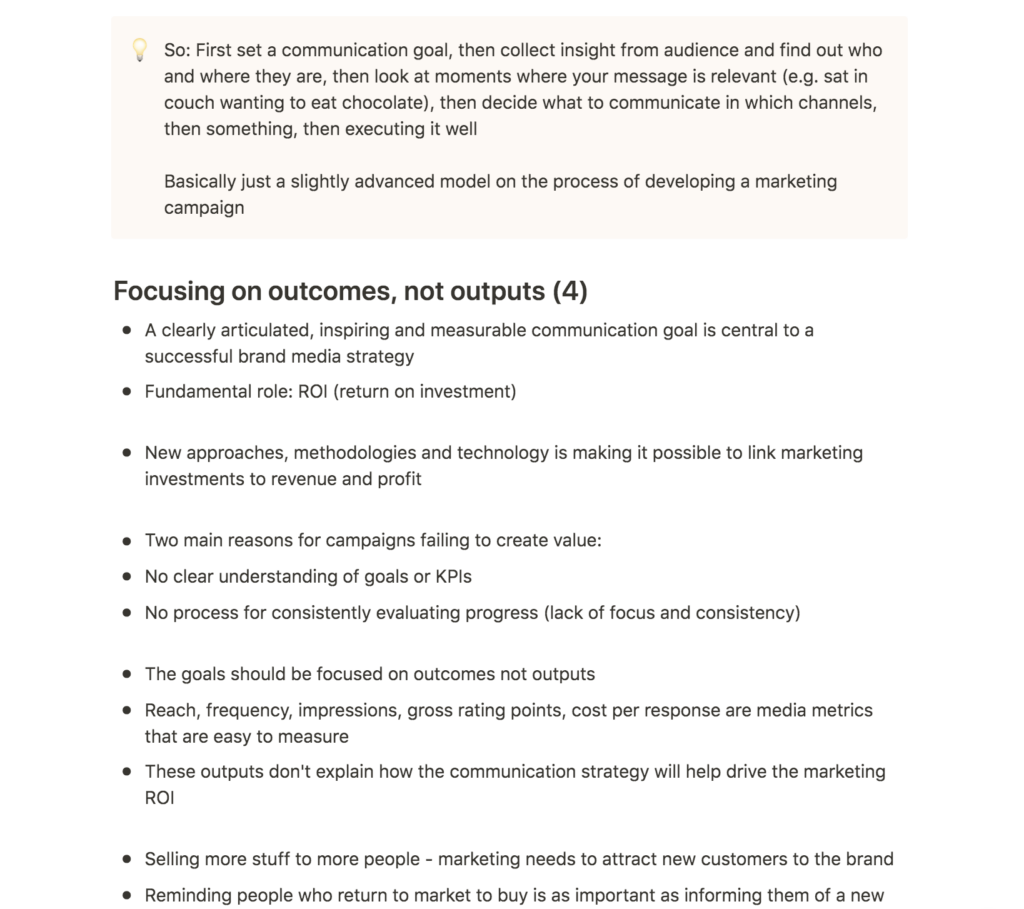
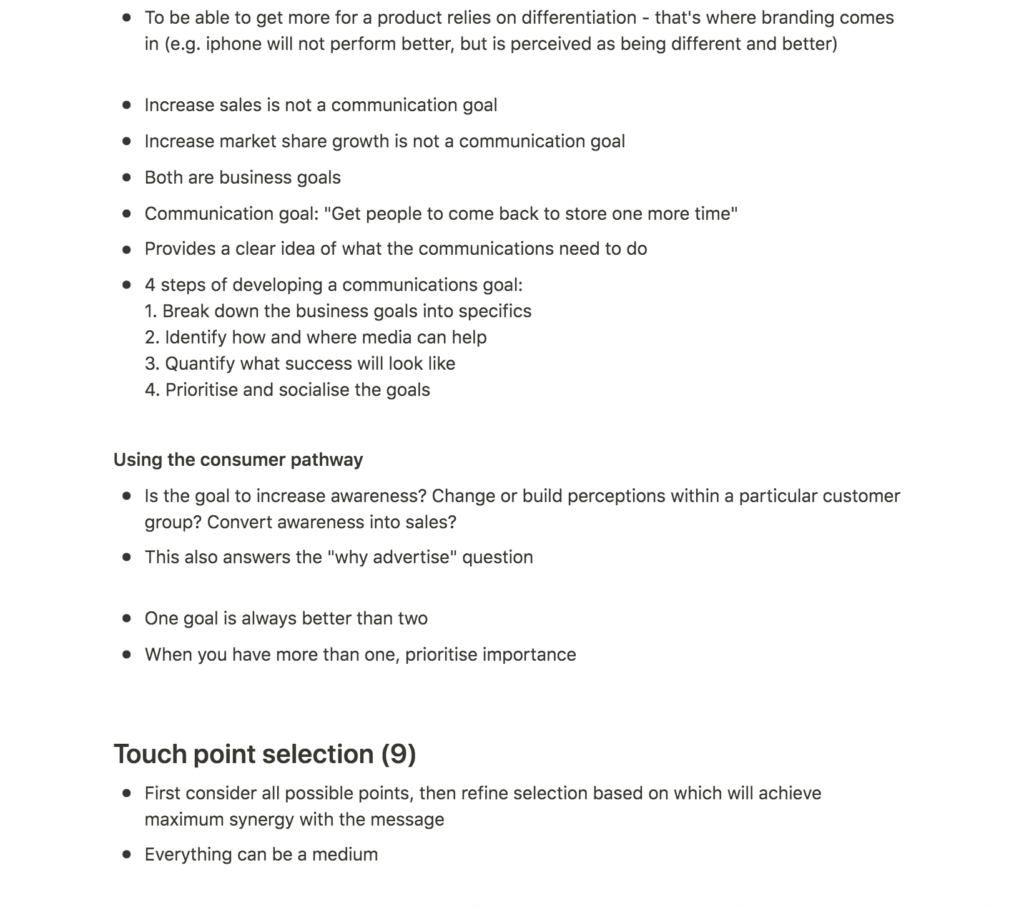
Resource reflections
When I first started reading this week’s resource, Brand Media Strategy – Planning in the Digital Era, I got confused. We haven’t actually chosen or developed a project yet, but we are already looking at marketing. I then assumed however, that a brand media strategy would be important to get in place quickly, in order to follow Parry’s advice of building an audience before the launch of a product (Dan Parry, 2021).
I liked Young’s suggestion of choosing a few channels and activities to focus on, and that all initiatives need to communicate one consistent message (Anthony Young, 2010). In today’s busy media landscape one might risk spreading oneself too thin if choosing to do everything, and thus the idea of doing one thing really well seems smart. As Young puts it, the brand media strategy should lead to a brand occupying a unique space for it’s own (Anthony Young, 2010).
To me, the consumer pathway was very helpful as it can help you understand the goal behind an initiative, whilst also understanding what the audience will need at any certain stage in order to move forward in the consumer loop (Anthony Young, 2010). I also think Young’s stress on having one prioritised communication goal was insightful (Anthony Young, 2010). This won’t only ensure consistency and meaning in your campaign, it can also help inspire ideas that are relevant for the ROI (Anthony Young, 2010).
Workshop challenge
I decided to go for my archive idea on Norwegian packaging from last week as this was the idea I thought would work best for targeting an audience. Designers are always on the lookout for inspiration and unique references, and besides, I also think there is a gap in the market for the conveying of Norwegian graphic design history (as reflected on in previous modules). If we’re discussing tactics I also think a project like this could provide value within a design audience, and perhaps help me make a name for myself within the Norwegian design community. Thus, this project would work well with the business plan from brief 1, where I’m suggesting to start my own practice as a one-person studio.
Process
Since working with audiences is quite a new area for me, I decided to follow Parry’s process, as presented in the lecture. I wanted to start the week off by looking at who my audience is and what they are trying to do, assumptions about my audience and product and market analysis and other design history projects. The hope was that this information would guide my distribution plan and further development of the project.
Audience
I started my audience research by noting down initial thoughts on my audience.
Who are they
- Graphic designers and other creatives
- Might be working within print/packaging
- People with in interest in art and visual aesthetics
What are they trying to do?
- Find visual and conceptual references/ideas for their design projects
- Create unique projects and outcomes
- Stay up to date on design trends
- Use shape and form to convey meaning
- Decorate their homes
- Feel inspired
- Be entertained
Why are they trying to do what they are trying to do?
- To succeed as designers
- To make money
- To grow (learn something new)
- To convince and please clients
- The feeling of having achieved something
- To feel relevant, that they have something to say and something to contribute
- To be a cultured person
What issues/problems do they have?
- Finding new references might not be a priority in a busy everyday
- Pinterest, Behance etc. is providing a very same-ish aesthetic
- Online imagery can quickly disappear because you end up pinning/saving so much material
- Picking up a book requires willpower (as apposed to just going on Pinterest or Behance)
- Takes time and coincidence to learn about a topic you wouldn’t necessarily know/think about
Instagram audience research
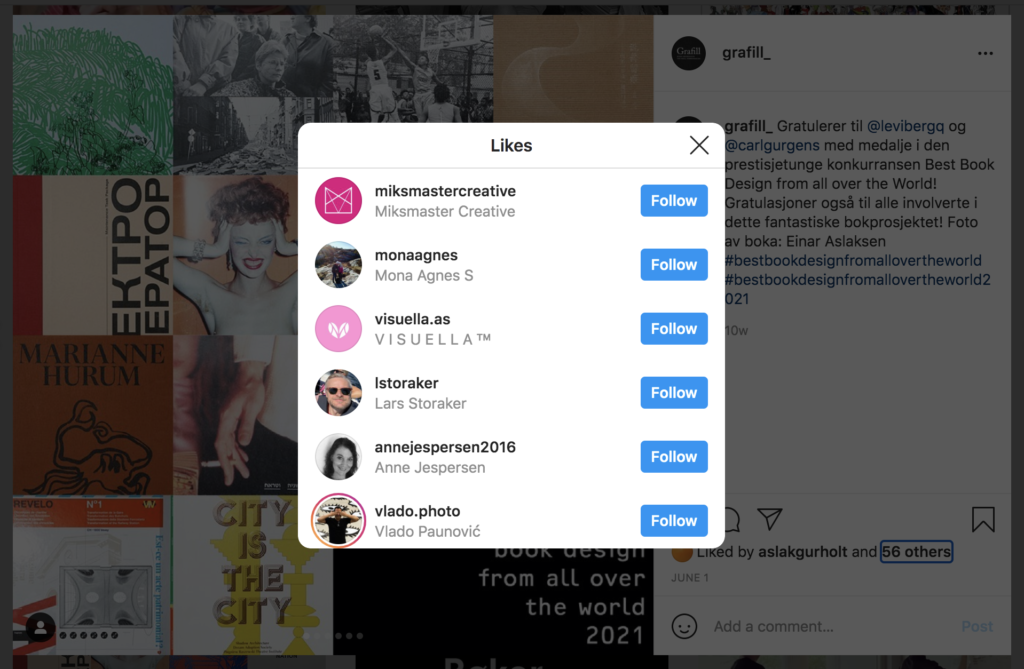
After noting down the reflections above, I went on to follow Parry’s advice on using social media to learn about nice audiences.
I started by looking at Grafill’s Instagram posts on other design books, which also led me to look at designers and local publishers in Norway. By looking at other accounts who had pressed like on relevant posts I noticed that the people behind those account had an interest for:
- Tactility
- Print and other analogue processes (like analogue photography)
- Typography (vernacular + letterpress)
- Interior design (vintage, Osloesque)
- Strange juxtapositions in the everyday life – seems slightly ironic
- Identifies with their craft – a lot of the accounts posts images of them at work or of their work on their personal accounts + keep some shape of “designer” in their bio
- Into more timeless graphic design, rather than only the hippest aesthetic
Most accounts seemed to be the private accounts of designers and illustrators, which is why I decided to keep them as my main audience. However, I also wanted to consider other creatives as part of my audience, as I believe they might have an interest for visual aesthetics.
Ideas wall survey
Since my audience consists of designers I decided to make a survey and put it on the ideas wall, in hope of gaining some real life insight that wasn’t just based on my own thoughts and assumptions. I tried to create very open and non-leading questions, according to Parry’s advice from the lecture. The questions were as follows:
- Can you talk me through your average day?
- What inspires you?
- Could you share any issues you might be having related to discovering references for your work?
- How do you discover references / find inspiration today? (had alternatives + an “other” option where one could write)
Although the amount of answers (5) weren’t high enough to provide accountable results, I still consider the results more meaningful than not conferring with anyone at all. If I had more time I would have made more of an effort to do in-depth interviews with other designers as I think this would have given more accountable insights. Below are some points that came up from my survey:
- Participants are inspired by a large range of sources, including: being outside, books (one participants mentions that they love collecting them), visiting exhibitions, materials, historic facts, art, nature, architecture, patterns and social media
- Some struggle with finding enough time for research, due to the short development time given for projects
- Going to exhibitions can be time consuming due to travel
- Finding specific references can be difficult – one participant says “I often let references find me through social media”
- Usage rights can be confusing and material can be labeled incorrectly
The information above tells me that designers draw inspiration from a large range of outputs, but that physical ones (like exhibitions) can sometimes be too time consuming. Seeking out references on specific topics can be difficult, and designers therefore seem to let references find them through social media, exhibitions, books, and their surroundings. I think the notion of wanting to collect books is an interesting point to look at, as I do have the impression that designers generally love to collect beautifully design physical objects (and that they rarely seem to have the same type of connection to collected digital references, e.g. on Pinterest).
Developing personas
Based on my audience reflections and research, I decided to create two personas that would summarise my findings:
The photographs used in this work were collected from creative commons websites and were not taken by me.
My audience research this week is focused on designers, and I think Mikkel would be my persona for my first 100 customers. As the product grows, I could also potentially start targeting a larger audience that are more like Sarah.
Assumptions
After reflecting upon and researching what my audience might look like, I went on to note down assumptions (as suggested in the lecture).
Assumptions about my audience
- Creatives find it difficult to discover unique visual inspiration
- They often collect references from social media, which makes it hard to develop unique aesthetics
- Feeling inspired by visual aesthetics can make them feel special, relevant, cultured, part of a certain community
- People are willing to pay for physical experiences and products, but not so much for digital inspiration
- They have an interest for retro packaging and would like to use it as inspiration
Assumptions about my abilities
- I would be able to design something inspiring using archive packaging
- I could write a book, but would need help from others when it comes to the historic info (if this is to be prioritised)
- I would be able to post regularly on social media in order to build a community
Assumptions about my product
- The packaging archive project could turn into an inspiring product which could help designers with visual references
- The product can be translated into several mediums (social media, publication, exhibition, digital archive, documentary, typeface, posters etc.)
- I could borrow material from the museums and archives that currently holds the packaging material
- I could collect more packaging from vintage shops
Market research
Amazon reviews
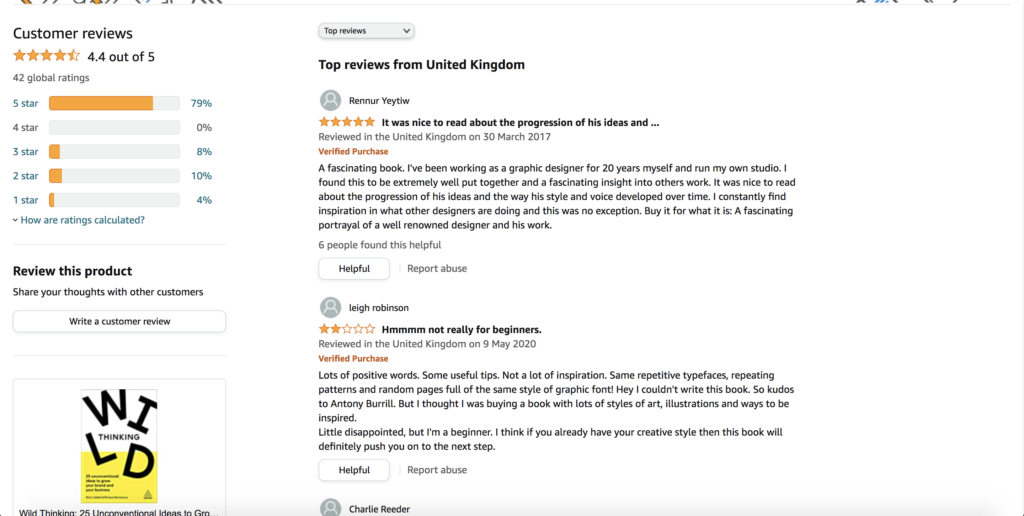
I started my market research by reading design book reviews on Amazon, in order to gain a better understanding about issues and opportunities related to the conveying of design.
Oportunities:
- Books to dip in and out of are convenient for those with busy lifestyles (and thus at work)
- Interesting to read about the progression of ideas + how a designer evolves over time
- Wanting to frame every page
- The ability to change someone’s perspective
- A book on design can also be meant for common folk, not only designers
- Help digital designers relate to their craft
- Help designers see a deeper meaning behind their work
- Introducing people to something they don’t know about, or had forgotten
- Lots of people seem to be buying design books as presents to other designers
- Look good on the book shelf
Issues:
- Repetitive typefaces and design can be boring and thus not inspiring
- Visually driven books can be read through very quickly and not provide a lot of verbal information
- Badly printed books (seems to be the issue that comes up most often)
- Attempting to be an educational book when it’s actually an inspiration book
How are issues solved today?
With my project I’m hoping to provide value in the shape of visual and contextual inspiration. As previously discussed, some issues related to this today is: 1: Social media (Pinterest, Instagram, Behance etc.) uses algorithms which makes it hard to discover new and unique aesthetics, 2: Online references are easily forgotten about because there is such an abundance of material, 3: Seeking out references outside of social media requires time and willpower.
In order to analyse how issues are solved today, I decided to tackle the them one by one by listing current tools, products and methods:
1: Social media is a valid source of inspiration. However, it uses algorithms, which makes it difficult to discover unique aesthetics.
- Publications let you dive into a theme and discover something that has been curated by people
- Going to museums, exhibitions and book shops (physical and digital)
- Using your surroundings
- Reading about phenomena outside your craft (e.g. using architecture as inspiration as a designer)
- Physically collecting references in sketch books
- Design blogs
- News letters
- Actively visiting other designers’ websites and channels
2: Online references are easily forgotten about.
- Building a physical archive (bookshelf, sketchbooks etc.)
- Saving references on desktop
- Writing a personal journal (like we do on this course)
- Notes on phone, Notion, Evernote etc.
3: Seeking out references outside of social media (picking up a book, going to an exhibition, learning something new) requires time and willpower
- News letters
- Design blogs
- Reading reviews of exhibitions, books etc.
- Digital archives
- Magazines (easier than books)
- Are.na
SWOT-analysis
At this stage I felt as if I had enough information to perform a SWOT-analysis.
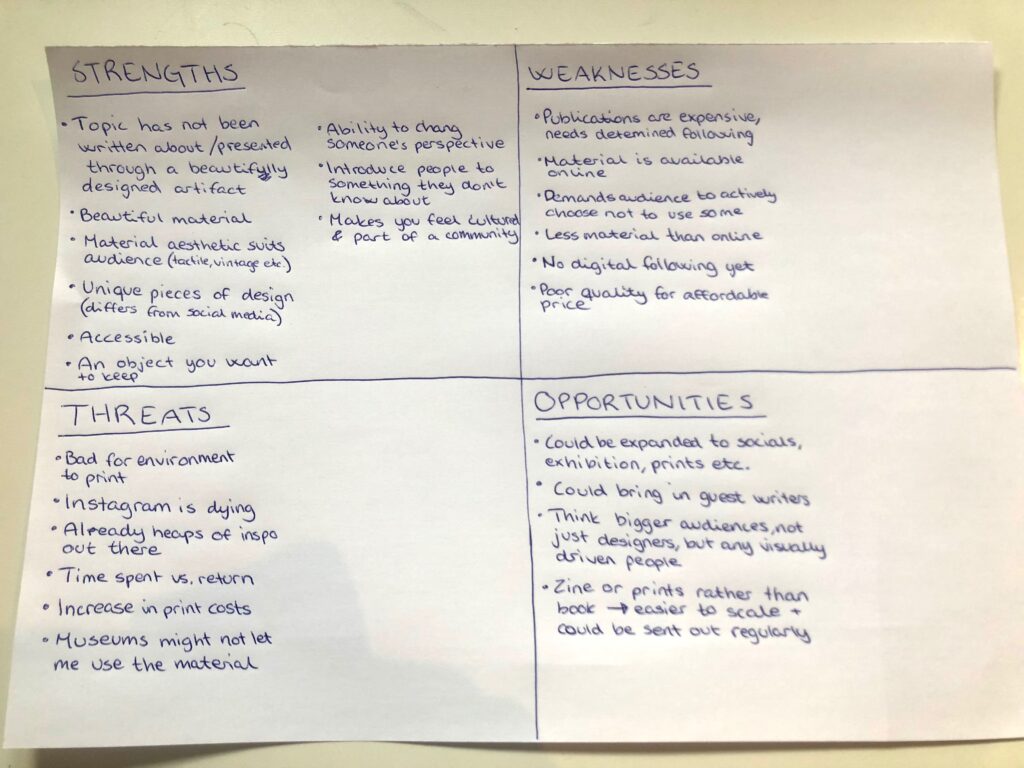
Although I intentionally hadn’t decided on a specific outcome for my project, I had been thinking of the outcome as a publication or exhibition up until this point. Whilst comparing the way my issues are solved today and performing my SWOT-analysis however, I got the idea of making a physical subscription service where users would receive regular pamphlets with archive inspiration in their mail. This solves the issue of social media algorithms, because I would be curating the content based on archive research. It also solves the book’s research of requiring willpower to read, because the pamphlet would be very short and image driven. Lastly it solves the issue of being forgotten about because it would be designed as a beautiful collectors object, developed to be kept as physical archives by users.
Sales and marketing
Social media and distribution
Following my prior reflections, I knew that I wanted to create a subscription service which lets creatives receive pamphlets with archive design references on a regular basis. Even though the product in itself would be physical, I wanted to follow Parry’s advice on building a social media community as a sales strategy. My audience research indicates that my consumers share a love for tactility and timeless design methods. Therefore, sharing photos of production and the product itself could appeal to potential buyers. The love for tactility could be taken even further by posting how to videos on how the product is printed/made. I also think it could be beneficial to post actual archive references, as this would provide value to the community who chooses to only follow the social accounts.
Using social media would also give me a chance to stay in touch with users through conversations on what’s to come, what they’d like to see next and any feedback.
Ideally I would have liked to distribute the product myself, as it’s got a small and therefore manageable production process.

Hashtags
As mentioned by Parry, one can use hashtags on Instagram to connect with niche audiences. Although I struggled to find very niche ones, I managed to discover a couple of relevant one:
- #Printisntdead
- #Printspotters
In addition I would also use hashtags related to the print methods I decide to use, for example:
- #risosquad
- #risography
- #risoprint
- #screenprinted
As the project is starting out, I also think it could be nice to mail free copies to selected designers and design studios.
Pricing
Due to the nature of my product, I wouldn’t need much financial matter to get started. My product will be developed as pamphlets, which means they can be sent as letters. I would therefore cover the printing and shipping costs for issue one out of my own pocket. Since my product is a subscription service, each copy would be paid for in advance, and the amount of copies would be equal to the amount of subscribers.
If I could manage to build a community of 1000 subscribers, each issue could be sold at 5GBP, with a production and shipping cost at 3,5GBP. This would result in an earning of 500GBP per month. If my product was to gain a substantial following I could also consider expanding to higher value products like books, exhibitions and larger prints, with a higher return.
Since my product is a small object that is easy to make, it would benefit from scaling. A large amount of orders would result in a decent return. Yet even if my product were to stay a small business, it would still provide value to me in the shape of self promotion. This comes on top of the essence of the product itself: sharing historic design pieces and encouraging inspiration across design communities.
Customer pathway
In order to develop my marketing plan further, I decided to brainstorm ideas based on the individual stages of the customer pathway (as presented in this week’s resource (Anthony Young, 2010)).
- Awareness
Through social media, I will build a community by providing value in shape of archive content and love for print
This is also where I will share any updates on upcoming issues, limited offer artefacts (if relevant in the future), and other launches
I will also mail free copies during the launch to selected designers and studios, in hope that they will want to subscribe and tell their friends about it - Involvement
The website will contain information about the product, and visualise the craft of the product
As the business grow, the website could also contain interviews and other content that there wasn’t room for in the pamphlet - Active consideration
(no activities in particular) - Purchase
Have a website that makes it easy to place an order
Make sure to collect feedback on website usability
Experiment with Instagram shopping and other easy to use solutions - Consumption
The first delivery of a subscription should include a welcome letter or other unique object
In order to iterate I will communicate regularly with my audience by interviewing, asking for feedback and testing
I will also ask for feedback and topic suggestions on social media in order to iterate and maintain a community conversation with my audience - Relationship building
In order to communicate with my audience in-between deliveries I hope to build a community on social where consumers will see updates on upcoming issues + other valuable content
I will also perform regular interviews with my audience in order to find out what content they wish to see in upcoming issues - Advocacy
When an individual customer has received a certain amount of issues (e.g. 3), they will receive an extra issue to give away as a gift
Make it easy for users to write reviews online
Actively comment on audience’s content on social, and make sure to encourage conversation on our own content – by being a “real person”, people might become more likely to recommend through social media
Always share user produced content on social media (e.g. if someone posts an image of the pamphlet on Instagram)
Considering todays market, Instagram would be the preferred channel for social media marketing. However, as the platform have started to focus more on video, times are changing and in the future I might have to consider other channels for the project.
Artefact development
Since I already knew what medium and concept I was going for, the artefact prototype development consisted of the visual identity development of the project. To recap, my product will be presenting and communicating Norwegian archive graphic design through a pamphlet subscription service. I spent some time looking at images of physical archives, and really fell in aspects from the image below. The wheel is a very typical archive object, and I liked the idea of using this as a logo symbol. I was also interested in the small holes in the metal walls, as well as the holes in the cardboard folders.

Further, I decided to spend some time looking at designed folders/pamphlets and I really fell inn love with the folding method of the one below. I liked how it used the folding as a way of including more information, and that the content also worked with the inside of the publication.
I also wanted to look at design that uses shape and form, since I had an idea of picking apart the graphic elements from the archive design and display it through a grid.
Fig. 9: Life Z 2021. Christmas winter dessert gift box. [ink on paper]
In order to develop further ideas I went on to reflect through sketches and writing.
After sketching I went on to experiment in illustrator. When looking at images of archives I noticed that several folders and objects were marked with marker text. I decided to experiment with this, in addition to writing out a name with dots (inspired by the metal wall holes mentioned above). The name, Arkiv. I didn’t spend much time on it, and if I have time next week I might look into other alternatives.
Through the above experiments I ended up with my final prototype layout, which is featured below. I wanted to develop a template design that could work for all issues. This way Arkiv would remain cohesive, whilst communicating a range of different design. I decided that the front page would feature a photograph of the object, in addition to a written analysis that attempts to inspire and bring forward new perspectives. Details from the packaging would be recreated on the back side, so that the reader can start to take apart each element of the design, in order to understand it better. The expressive headings are meant to appeal to the typography lovers in my audience and the line drawing on the “cover” will change from issue to issue. So will the colours.
As mentioned previously, I would like to use tradition printing methods like reso or screen printing, in order to appeal to my audience’s interest for production methods. In order to test my design however, I decided to make a physical prototype using my at-home printer.
If I had more time (and if I get time next week I might work further on this) I would have liked to work further on the presentation of individual design elements. At the moment I think it crashes with the front page, and grid lines don’t really work. I also would have liked to make the elements more like the original packaging, as some of the typography has been made with existing digital type. I also wonder wether I could work on the elements to create something new, which isn’t just a translation of the vintage design. Of course, I also would have liked to work on the written analysis if I was to see this project through to a finished stage.
As I was working on the project, I thought it could have been nice to create a website as well, which could include further information that didn’t make the cut, or perhaps digital content like video and animation.
Presentation
In order to present this week’s material (as asked for in the workshop challenge) I went on to create a one-page summary by combining my insights, concepts and visual development:

Final result
Through reflections on designers’ issues related to sourcing inspiration and new references, I have identified three issues that my product, Arkiv will attempt to solve:
- Social media can provide a large amount of inspiration. However, it uses algorithms, which makes it difficult to discover unique aesthetics that differ from what you have already been exposed to.
- Online references are easily forgotten about due to the large scale and endless space one is free to take up online.
- Seeking out references outside of social media (for example through books or exhibitions) requires time and willpower.
By creating a physical subscription service, where users receive a pamphlet that discusses a piece of archive design, Arkiv provides unique references on unknown or forgotten topics. The small format makes the content readily available (in favour of the creator’s hectic lifestyle), and the physicality encourages collection and display (which means it won’t be forgotten about as easily). Arkiv uses the perks of social media (fresh content delivered to you regularly), and mixes it with the coincidental and perhaps more meditative context of physical books or exhibitions.
Arkiv is created for graphic designers and other creatives with a love for tactility and production methods. Through beautiful design and tactile printing methods, Arkiv is targeted towards those who care deeply about analogue objects.
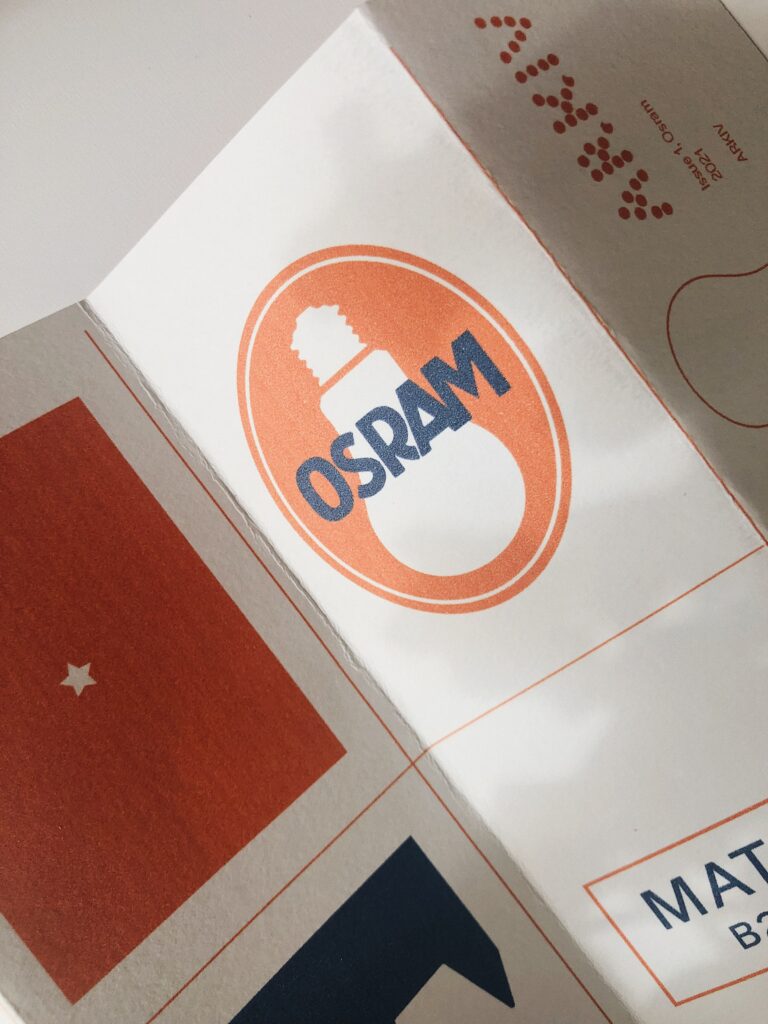
In conclusion
I have always thought that the audience was something you’d identify after a product had been made, and so it was great to see how my audience research ended up affecting my development decisions this week. The SWOT analysis was also very helpful as this was what got me the idea of a pamphlet subscription service. What’s interesting is that I previously thought about these methods as business tools, but in the end they ended up being very useful in terms of creative development.
Although I have attempted to do a varied audience research, I think I would have benefited from doing face to face interviews this week. This could have let me discover new issues, but it also could have helped me understand wether my assumptions were correct or not. I also think my concept should have been tested in order to find out wether it would be relevant to my audience.
Moving forward I hope to get time to improve my prototype further. I think the design could be improved, particularly the page with individual design elements. I also think it could be good to create a second issue, in order to illustrate and test the cohesiveness of the design system. This might also help to communicate the value of collection that I hope my product encourages. Lastly, I think my marketing plan was poorly researched, and so I might also try to look further into this next week.
REFERENCES:
Anthony Young (2010) Brand Media Strategy – Planning in the Digital Era. London: Palgrave Macmillan.
Dan Parry (2021) ‘Lecture: Dan Parry’. Canvas Falmouth Flexible [online], 6 August.
LIST OF FIGURES:
Figure 1. WORDSTREAM. Ca. 2018-2021. SWOT analysis. WordStream [online]. Available at: https://www.wordstream.com/blog/ws/2017/12/20/swot-analysis
Figure. 2. Grafill on Instagram 12 August 2021. [screenshot by the author]
Figure 3-4: Ingrid REIGSTAD. 2021. Personas. Private collection: Ingrid Reigstad.
Figure. 5. Make it Now reviews on Amazon 12 August 2021. [screenshot by the author]
Figure. 6. #risoprint on Instagram 12 August 2021. [screenshot by the author]
Figure 7. Unknown maker. ca. 2010-2021. No title. [photograph]. National Archives of Australia on LinkedIn [online]. Available at: https://www.linkedin.com/company/national-archives-of-australia/?originalSubdomain=au [accessed 13 August 2021].
Figure 8. Alice HELFER. 2019. Mutations. Alice Helfer [online]. Available at: https://alicehelfer.com/
Figure 9. LIFE Z. 2021. Christmas winter dessert gift box. Behance [online]. Available at: https://www.behance.net/gallery/114976499/_
Figure 10-13: Ingrid REIGSTAD. 2021. Experiments Arkiv. Private collection: Ingrid Reigstad.
Figure 14-15: Ingrid REIGSTAD. 2021. Arkiv prototype spreads. Private collection: Ingrid Reigstad.
Figure 16-21: Ingrid REIGSTAD. 2021. Arkiv prototype. Private collection: Ingrid Reigstad.
Figure 22: Ingrid REIGSTAD. 2021. Arkiv: report. Private collection: Ingrid Reigstad.
Figure 23: Ingrid REIGSTAD. 2021. Arkiv prototype. Private collection: Ingrid Reigstad.


